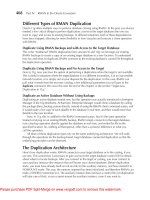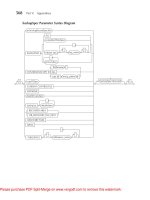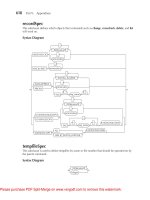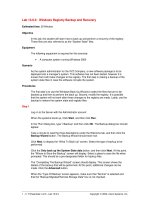Oracle Database Backup and Recovery Basics
Bạn đang xem bản rút gọn của tài liệu. Xem và tải ngay bản đầy đủ của tài liệu tại đây (911.65 KB, 216 trang )
Oracle® Database
Backup and Recovery Basics
10g Release 1 (10.1)
Part No. B10735-01
December 2003
Oracle Database Backup and Recovery Basics 10g Release 1 (10.1)
Part No. B10735-01
Copyright © 2003 Oracle Corporation. All rights reserved.
Primary Author: Antonio Romero
Contributing Author:
Lance Ashdown
Contributors: Anand Beldalker, Tammy Bednar, Don Beusee, Senad Dizdar, Wei Hu, Donna Keesling,
Bill Lee, Muthu Olagappan, Francisco Sanchez, Vinay Srihari, Steve Wertheimer
Graphic Artist:
Valarie Moore
The Programs (which include both the software and documentation) contain proprietary information of
Oracle Corporation; they are provided under a license agreement containing restrictions on use and
disclosure and are also protected by copyright, patent and other intellectual and industrial property
laws. Reverse engineering, disassembly or decompilation of the Programs, except to the extent required
to obtain interoperability with other independently created software or as specified by law, is prohibited.
The information contained in this document is subject to change without notice. If you find any problems
in the documentation, please report them to us in writing. Oracle Corporation does not warrant that this
document is error-free. Except as may be expressly permitted in your license agreement for these
Programs, no part of these Programs may be reproduced or transmitted in any form or by any means,
electronic or mechanical, for any purpose, without the express written permission of Oracle Corporation.
If the Programs are delivered to the U.S. Government or anyone licensing or using the programs on
behalf of the U.S. Government, the following notice is applicable:
Restricted Rights Notice Programs delivered subject to the DOD FAR Supplement are "commercial
computer software" and use, duplication, and disclosure of the Programs, including documentation,
shall be subject to the licensing restrictions set forth in the applicable Oracle license agreement.
Otherwise, Programs delivered subject to the Federal Acquisition Regulations are "restricted computer
software" and use, duplication, and disclosure of the Programs shall be subject to the restrictions in FAR
52.227-19, Commercial Computer Software - Restricted Rights (June, 1987). Oracle Corporation, 500
Oracle Parkway, Redwood City, CA 94065.
The Programs are not intended for use in any nuclear, aviation, mass transit, medical, or other inherently
dangerous applications. It shall be the licensee's responsibility to take all appropriate fail-safe, backup,
redundancy, and other measures to ensure the safe use of such applications if the Programs are used for
such purposes, and Oracle Corporation disclaims liability for any damages caused by such use of the
Programs.
Oracle is a registered trademark, and Oracle Store, Oracle7, Oracle8, Oracle9i, PL/SQL, and SQL*Plus are
trademarks or registered trademarks of Oracle Corporation. Other names may be trademarks of their
respective owners.
Contents
Send Us Your Comments ................................................................................................................... ix
Preface............................................................................................................................................................ xi
Audience ................................................................................................................................................ xii
Organization.......................................................................................................................................... xii
Related Documentation ...................................................................................................................... xiii
Conventions.......................................................................................................................................... xiii
Documentation Accessibility ............................................................................................................. xvi
1
Backup and Recovery Overview
What is Backup and Recovery? .......................................................................................................
Physical Backups and Logical Backups.....................................................................................
Errors and Failures Requiring Recovery from Backup ...........................................................
Oracle Backup and Recovery Solutions: RMAN and User-Managed Backup ....................
Backup and Recovery: Basic Concepts ...........................................................................................
Physical Database Structures Used in Recovering Data .........................................................
The Database Recovery Process: Basic Concepts .........................................................................
Forms of Data Recovery.....................................................................................................................
Datafile Media Recovery: Restore Datafiles, Apply Redo......................................................
Complete, Incomplete and Point-In-Time Recovery.............................................................
Automatic Recovery After Instance Failure: Crash Recovery .............................................
Backup and Recovery with RMAN ...............................................................................................
Types of Oracle Database Backup under RMAN ..................................................................
Matching Failures to Backup and Recovery Techniques ..........................................................
1-2
1-2
1-2
1-3
1-5
1-5
1-7
1-9
1-9
1-10
1-11
1-12
1-12
1-14
iii
Media Failure...............................................................................................................................
User Error.....................................................................................................................................
Automatic Disk-Based Backup and Recovery: The Flash Recovery Area .............................
System Requirements for Backup and Recovery Methods ......................................................
Feature Comparison of Backup Methods.....................................................................................
2
Backup and Recovery Strategies
Data Recovery Strategy Determines Backup Strategy.................................................................
Planning Data Recovery Strategy ....................................................................................................
Planning a Response to User Error: Point-in-Time Recovery and Flashback Features......
Planning a Response to Media Failure: Restore and Media Recovery .................................
Planning a Response to Datafile Block Corruption: Block Media Recovery........................
Planning Backup Strategy .................................................................................................................
Protecting Your Redundancy Set ...............................................................................................
Deciding Between ARCHIVELOG and NOARCHIVELOG Mode .....................................
Deciding Whether to Use a Flash Recovery Area ..................................................................
Choosing a Backup Retention Policy .......................................................................................
Archiving Older Backups ..........................................................................................................
Determining Backup Frequency...............................................................................................
Performing Backups Before and After You Make Structural Changes...............................
Backing Up Frequently Used Tablespaces ..............................................................................
Backing Up after NOLOGGING Operations..........................................................................
Exporting Data for Added Protection and Flexibility ...........................................................
Preventing the Backup of Online Redo Logs..........................................................................
Keeping Records of the Hardware and Software Configuration of the Server .................
Validating Your Data Recovery Strategy ......................................................................................
Validating RMAN Backups: BACKUP VALIDATE and RESTORE VALIDATE .............
3
2-2
2-5
2-5
2-6
2-7
2-8
2-8
2-10
2-11
2-12
2-14
2-14
2-15
2-15
2-16
2-16
2-17
2-17
2-18
2-19
Setting Up and Configuring Backup and Recovery
Starting and Exiting RMAN: Overview..........................................................................................
Types of Database Connections..................................................................................................
Authentication for Database Connections ................................................................................
Setting Globalization Support Environment Variables for RMAN .........................................
Connecting to the Target Database..................................................................................................
Connecting to the Target Database from the Command Line ...............................................
iv
1-14
1-16
1-16
1-17
1-18
3-2
3-2
3-3
3-3
3-4
3-4
Connecting to the Target Database from the RMAN Prompt ...............................................
Setting Up a Database for RMAN Backup ....................................................................................
Persistent Configuration Settings: Controlling RMAN Behavior .........................................
Configuring the Default Device Type for Backups .................................................................
Configuring the Default Backup Type for Disk Backups .......................................................
Configuring Compressed Backupsets as Default for Tape or Disk.......................................
Configuring Disk Devices and Channels ..................................................................................
Configuring Tape Devices and Channels .................................................................................
Configuring Control File and Server Parameter File Autobackup .......................................
Setting Up a Flash Recovery Area for RMAN.............................................................................
Choosing a Location for the Flash Recovery Area.................................................................
Files That Can Be Stored in the Flash Recovery Area ...........................................................
Planning the Size of the Flash Recovery Area........................................................................
Setting Initialization Parameters for the Flash Recovery Area ............................................
Configuring the Backup Retention Policy .............................................................................
How Oracle Manages Disk Space in the Flash Recovery Area............................................
Configure Flash Recovery Area for Disk-Based Backups: Example ...................................
Creating a Database with Multiplexed Files in the Flash Recovery Area: Scenario.........
Creating a Database with Only Archived Logs in the Flash Recovery Area: Scenario....
4
3-5
3-5
3-6
3-7
3-7
3-8
3-8
3-9
3-9
3-11
3-12
3-13
3-13
3-14
3-18
3-20
3-22
3-23
3-25
Making Backups with Recovery Manager
Overview of RMAN Backups...........................................................................................................
Files That RMAN Can Back Up..................................................................................................
RMAN Backup Formats: Image Copies and Backup Sets ......................................................
Full and Incremental Datafile Backups .....................................................................................
RMAN Backups and Tags ...........................................................................................................
Backing Up Database Files and Archived Logs with RMAN ....................................................
Making Consistent and Inconsistent Backups with RMAN ..................................................
Making Whole Database Backups with RMAN.......................................................................
Backing Up Individual Tablespaces with RMAN ...................................................................
Backing Up Datafiles and Datafile Copies with RMAN........................................................
Backing Up Control Files with RMAN......................................................................................
Backing Up Server Parameter Files with RMAN...................................................................
Backing Up Archived Redo Logs with RMAN ......................................................................
Using Compressed Backupsets.................................................................................................
4-2
4-2
4-3
4-5
4-5
4-5
4-6
4-6
4-7
4-8
4-9
4-10
4-10
4-12
v
RMAN Incremental Backups..........................................................................................................
Making Incremental Backups: BACKUP INCREMENTAL ..............................................
Incrementally Updated Backups: Rolling Forward Image Copy Backups ........................
Improving Incremental Backup Performance: Change Tracking........................................
Backing Up to the Flash Recovery Area: Basic Scenarios .........................................................
Scripting Disk-Only Backups ....................................................................................................
Backing Up to the Flash Recovery Area and to Tape: Basic Scenarios ...................................
Configuring the RMAN Environment for Disk and Tape Backups ....................................
Writing Backup Scripts for Disk and Tape Scenarios............................................................
Validating RMAN Backups.............................................................................................................
Overview of Querying the RMAN Repository ...........................................................................
Listing RMAN Backups, Archived Logs, and Database Incarnations....................................
About RMAN Lists.....................................................................................................................
Listing Backups ...........................................................................................................................
Listing Backups in Summary Mode.........................................................................................
Listing Backups with Restrictions ............................................................................................
Listing Database Incarnations...................................................................................................
Reporting on Backups and Database Schema.............................................................................
About RMAN Reports ...............................................................................................................
Reporting on Objects Needing a Backup ................................................................................
Reporting Obsolete Backups .....................................................................................................
Reporting on the Database Schema..........................................................................................
5
Performing Recovery
Database Restore and Recovery with RMAN: Overview ...........................................................
Scope and Limitations of this Chapter ......................................................................................
Restore and Recovery with Enterprise Manager .....................................................................
Preparing and Planning Database Restore and Recovery...........................................................
Database Restore and Recovery Procedure: Outline...............................................................
Determining Which Database Files to Restore or Recover .....................................................
Determining your DBID ..............................................................................................................
Previewing Backups Used in Restore Operations: RESTORE PREVIEW ............................
Validating the Restore of Backups: RESTORE VALIDATE....................................................
Basic Database Restore and Recovery Scenarios ........................................................................
Whole Database Restore and Recovery: Scenario..................................................................
vi
4-13
4-19
4-20
4-23
4-25
4-26
4-32
4-33
4-33
4-42
4-43
4-44
4-44
4-45
4-48
4-48
4-50
4-51
4-51
4-52
4-53
4-54
5-2
5-3
5-3
5-4
5-4
5-5
5-8
5-8
5-9
5-11
5-12
Restore and Recovery of Individual Tablespaces or Datafiles: Scenario............................
Restoring Different Types of Lost Database Files with RMAN..............................................
Restoring the Control File from Backup..................................................................................
Restoring the Server Parameter File (SPFILE) from Backup................................................
Restoring and Recovering Datafiles and Tablespaces to a New Location .........................
Restoring Archived Redo Logs from Backup.........................................................................
6
5-13
5-14
5-14
5-17
5-19
5-23
Recovery Manager Maintenance Tasks
Managing the RMAN Repository Without a Recovery Catalog................................................
Backing Up and Restoring the Control File ..............................................................................
Monitoring the Overwriting of Control File Records .............................................................
Maintaining the RMAN Repository in the Control File.............................................................
Crosschecking Backups ...............................................................................................................
Deleting Backups ..........................................................................................................................
Crosschecking and Deleting on Multiple RMAN Channels ...................................................
About Allocating Multiple RMAN Channels for Maintenance Commands .....................
How RMAN Crosschecks and Deletes on Multiple Channels ............................................
Crosschecking Disk and Tape Channels with One Command: Example ..........................
Crosschecking on Multiple Oracle Real Application Cluster Nodes: Example ................
Deleting on Disk and Tape Channels with One DELETE Command: Example ...............
Releasing Multiple Channels: Example...................................................................................
Deleting a Database with RMAN.............................................................................................
Changing the Status of a Backup Record.....................................................................................
Marking a Backup AVAILABLE or UNAVAILABLE...........................................................
Exempting a Backup from the Retention Policy ....................................................................
Cataloging Archived Logs and User-Managed Copies .............................................................
About Cataloging Archived Logs and User-Managed Copies ............................................
Cataloging User-Managed Datafile Copies ............................................................................
Cataloging Backup Pieces..........................................................................................................
Cataloging All Files in a Disk Location ...................................................................................
Uncataloging RMAN Records........................................................................................................
About Uncataloging RMAN Records ......................................................................................
Removing Records for Files Deleted with Operating System Utilities...............................
Flash Recovery Area Maintenance ................................................................................................
Resolving a Full Flash Recovery Area .....................................................................................
6-2
6-2
6-2
6-5
6-5
6-7
6-11
6-11
6-11
6-12
6-13
6-13
6-15
6-15
6-16
6-16
6-17
6-17
6-18
6-19
6-19
6-20
6-21
6-21
6-21
6-22
6-22
vii
Changing the Flash Recovery Area to a New Location ........................................................ 6-23
Flash Recovery Area Behavior When Instance Crashes During File Creation .................. 6-23
Glossary
Index
viii
Send Us Your Comments
Oracle Database Backup and Recovery Basics 10g Release 1 (10.1)
Part No. B10735-01
Oracle Corporation welcomes your comments and suggestions on the quality and usefulness of this
document. Your input is an important part of the information used for revision.
■
■
■
■
■
Did you find any errors?
Is the information clearly presented?
Do you need more information? If so, where?
Are the examples correct? Do you need more examples?
What features did you like most?
If you find any errors or have any other suggestions for improvement, please indicate the document
title and part number, and the chapter, section, and page number (if available). You can send comments to us in the following ways:
■
■
■
Electronic mail:
FAX: (650) 506-7227 Attn: Server Technologies Documentation Manager
Postal service:
Oracle Corporation
Server Technologies Documentation
500 Oracle Parkway, Mailstop 4op11
Redwood Shores, CA 94065
USA
If you would like a reply, please give your name, address, telephone number, and (optionally) electronic mail address.
If you have problems with the software, please contact your local Oracle Support Services.
ix
x
Preface
This guide provides a basic conceptual overview of Oracle database backup and
recovery.
This preface contains these topics:
■
Audience
■
Organization
■
Related Documentation
■
Conventions
■
Documentation Accessibility
xi
Audience
This manual is intended for database administrators who perform backup and
recovery of an Oracle database server.
To use this document, you need to know the following:
■
■
Relational database concepts and basic database administration as described in
Oracle Database Concepts and Oracle Database Administrator's Guide
The operating system environment under which you are running the Oracle
database
Organization
This document contains:
Chapter 1, "Backup and Recovery Overview"
This chapter briefly introduces the basic concepts of Oracle database backup and
recovery.
Chapter 2, "Backup and Recovery Strategies"
This chapter gives general recommendations for a backup and recovery strategy.
Chapter 3, "Setting Up and Configuring Backup and Recovery"
This chapter describes how to prepare RMAN for initial use.
Chapter 4, "Making Backups with Recovery Manager"
This chapter describes how to use the RMAN BACKUP command.
Chapter 5, "Performing Recovery"
This chapter describes how to use the RMAN RESTORE and RECOVER commands.
Chapter 6, "Recovery Manager Maintenance Tasks"
This chapter describes how to maintain the RMAN backup metadata, which is
stored in the control file of the target database.
"Glossary"
This chapter defines common backup and recovery terms.
xii
Related Documentation
For more information, see these Oracle resources:
■
Oracle Database Recovery Manager Quick Start Guide
■
Oracle Database Backup and Recovery Advanced User's Guide
■
Oracle Database Recovery Manager Reference
■
Oracle Database SQL Reference
■
Oracle Database Utilities
Many of the examples in this book use the sample schemas of the seed database,
which is installed by default when you install Oracle. Refer to Oracle Database
Sample Schemas for information on how these schemas were created and how you
can use them yourself.
Printed documentation is available for sale in the Oracle Store at
/>
To download free release notes, installation documentation, white papers, or other
collateral, please visit the Oracle Technology Network (OTN). You must register
online before using OTN; registration is free and can be done at
/>
If you already have a username and password for OTN, then you can go directly to
the documentation section of the OTN Web site at
m/documentation/
Conventions
This section describes the conventions used in the text and code examples of this
documentation set. It describes:
■
Conventions in Text
■
Conventions in Code Examples
Conventions in Text
We use various conventions in text to help you more quickly identify special terms.
The following table describes those conventions and provides examples of their use.
xiii
Convention
Meaning
Bold
Bold typeface indicates terms that are
When you specify this clause, you create an
defined in the text or terms that appear in index-organized table.
a glossary, or both.
Italics
Italic typeface indicates book titles or
emphasis.
Oracle Database Concepts
Uppercase monospace typeface indicates
elements supplied by the system. Such
elements include parameters, privileges,
datatypes, RMAN keywords, SQL
keywords, SQL*Plus or utility commands,
packages and methods, as well as
system-supplied column names, database
objects and structures, usernames, and
roles.
You can specify this clause only for a NUMBER
column.
Lowercase monospace typeface indicates
executables, filenames, directory names,
and sample user-supplied elements. Such
elements include computer and database
names, net service names, and connect
identifiers, as well as user-supplied
database objects and structures, column
names, packages and classes, usernames
and roles, program units, and parameter
values.
Enter sqlplus to open SQL*Plus.
UPPERCASE
monospace
(fixed-width)
font
lowercase
monospace
(fixed-width)
font
Example
Ensure that the recovery catalog and target
database do not reside on the same disk.
You can back up the database by using the
BACKUP command.
Query the TABLE_NAME column in the USER_
TABLES data dictionary view.
Use the DBMS_STATS.GENERATE_STATS
procedure.
The password is specified in the orapwd file.
Back up the datafiles and control files in the
/disk1/oracle/dbs directory.
The department_id, department_name, and
location_id columns are in the
hr.departments table.
Set the QUERY_REWRITE_ENABLED initialization
parameter to true.
Note: Some programmatic elements use a
mixture of UPPERCASE and lowercase.
Connect as oe user.
Enter these elements as shown.
The JRepUtil class implements these methods.
lowercase
Lowercase italic monospace font
italic
represents placeholders or variables.
monospace
(fixed-width)
font
You can specify the parallel_clause.
Run Uold_release.SQL where old_release
refers to the release you installed prior to
upgrading.
Conventions in Code Examples
Code examples illustrate SQL, PL/SQL, SQL*Plus, or other command-line
statements. They are displayed in a monospace (fixed-width) font and separated
from normal text as shown in this example:
SELECT username FROM dba_users WHERE username = 'MIGRATE';
xiv
The following table describes typographic conventions used in code examples and
provides examples of their use.
Convention
Meaning
Example
[ ]
Brackets enclose one or more optional
items. Do not enter the brackets.
DECIMAL (digits [ , precision ])
{ }
Braces enclose two or more items, one of
which is required. Do not enter the
braces.
{ENABLE | DISABLE}
|
A vertical bar represents a choice of two
{ENABLE | DISABLE}
or more options within brackets or braces. [COMPRESS | NOCOMPRESS]
Enter one of the options. Do not enter the
vertical bar.
...
Horizontal ellipsis points indicate either:
■
■
.
.
.
That we have omitted parts of the
code that are not directly related to
the example
That you can repeat a portion of the
code
Vertical ellipsis points indicate that we
have omitted several lines of code not
directly related to the example.
Other notation
You must enter symbols other than
brackets, braces, vertical bars, and ellipsis
points as shown.
Italics
Italicized text indicates placeholders or
variables for which you must supply
particular values.
CREATE TABLE ... AS subquery;
SELECT col1, col2, ... , coln FROM
employees;
SQL> SELECT NAME FROM V$DATAFILE;
NAME
-----------------------------------/fsl/dbs/tbs_01.dbf
/fs1/dbs/tbs_02.dbf
.
.
.
/fsl/dbs/tbs_09.dbf
9 rows selected.
acctbal NUMBER(11,2);
acct
CONSTANT NUMBER(4) := 3;
CONNECT SYSTEM/system_password
DB_NAME = database_name
xv
Convention
Meaning
Example
UPPERCASE
Uppercase typeface indicates elements
supplied by the system. We show these
terms in uppercase in order to distinguish
them from terms you define. Unless terms
appear in brackets, enter them in the
order and with the spelling shown.
However, because these terms are not
case sensitive, you can enter them in
lowercase.
SELECT last_name, employee_id FROM
employees;
SELECT * FROM USER_TABLES;
DROP TABLE hr.employees;
lowercase
Lowercase typeface indicates
programmatic elements that you supply.
For example, lowercase indicates names
of tables, columns, or files.
SELECT last_name, employee_id FROM
employees;
sqlplus hr/hr
CREATE USER mjones IDENTIFIED BY ty3MU9;
Note: Some programmatic elements use a
mixture of UPPERCASE and lowercase.
Enter these elements as shown.
Documentation Accessibility
Our goal is to make Oracle products, services, and supporting documentation
accessible, with good usability, to the disabled community. To that end, our
documentation includes features that make information available to users of
assistive technology. This documentation is available in HTML format, and contains
markup to facilitate access by the disabled community. Standards will continue to
evolve over time, and Oracle Corporation is actively engaged with other
market-leading technology vendors to address technical obstacles so that our
documentation can be accessible to all of our customers. For additional information,
visit the Oracle Accessibility Program Web site at
/>
JAWS, a Windows screen
reader, may not always correctly read the code examples in this document. The
conventions for writing code require that closing braces should appear on an
otherwise empty line; however, JAWS may not always read a line of text that
consists solely of a bracket or brace.
Accessibility of Code Examples in Documentation
Accessibility of Links to External Web Sites in Documentation This
documentation may contain links to Web sites of other companies or organizations
xvi
that Oracle does not own or control. Oracle neither evaluates nor makes any
representations regarding the accessibility of these Web sites.
xvii
xviii
1
Backup and Recovery Overview
This chapter provides a general overview of backup and recovery concepts, the files
in an Oracle database related to backup and recovery, and the tools available for
making backups of your database, recovering from data loss or other error, and
maintaining records of your backups.
This chapter includes the following topics:
■
What is Backup and Recovery?
■
Backup and Recovery: Basic Concepts
■
The Database Recovery Process: Basic Concepts
■
Forms of Data Recovery
■
Backup and Recovery with RMAN
■
Matching Failures to Backup and Recovery Techniques
■
Automatic Disk-Based Backup and Recovery: The Flash Recovery Area
■
System Requirements for Backup and Recovery Methods
■
Feature Comparison of Backup Methods
Backup and Recovery Overview 1-1
What is Backup and Recovery?
What is Backup and Recovery?
In general, backup and recovery refers to the various strategies and procedures
involved in protecting your database against data loss and reconstructing the
database after any kind of data loss.
Physical Backups and Logical Backups
A backup is a copy of data from your database that can be used to reconstruct that
data. Backups can be divided into physical backups and logical backups.
Physical backups are backups of the physical files used in storing and recovering
your database, such as datafiles, control files, and archived redo logs. Ultimately,
every physical backup is a copy of files storing database information to some other
location, whether on disk or some offline storage such as tape.
Logical backups contain logical data (for example, tables or stored procedures)
exported from a database with an Oracle export utility and stored in a binary file,
for later re-importing into a database using the corresponding Oracle import utility..
See also: Oracle Database Utilities for more details about
importing and exporting data using Oracle export and import
utilities.
Physical backups are the foundation of any sound backup and recovery strategy.
Logical backups are a useful supplement to physical backups in many
circumstances but are not sufficient protection against data loss without physical
backups.
Unless otherwise specified, the term "backup" as used in the backup and recovery
documentation refers to physical backups, and to backup part or all of your
database is to take some kind of physcial backup. The focus in the backup and
recovery documentation set will be almost exclusively on physical backups.
Errors and Failures Requiring Recovery from Backup
While there are several types of problem that can halt the normal operation of an
Oracle database or affect database I/O operations, only two typically require DBA
intervention and media recovery: media failure, and user errors.
Other failures may require DBA intervention to restart the database (after an
instance failure) or allocate more disk space (after statement failure due to, for
instance, a full datafile) but these situations will not generally cause data loss or
require recovery from backup.
1-2 Backup and Recovery Basics









